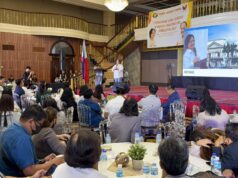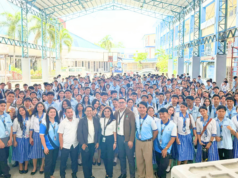Maria Valtorta was born on March 14, 1897 in Italy. In 1917 Maria entered the ranks of the Samaritan Nurses and for 18 months served at the military hospital in Florence.
Her life changed on March 17, 1920 while she was walking along a street with her mother when she was struck in the back by a delinquent. She remained in bed for three months, but this incident would later lead to her complete infirmity.
Starting April 1934, Maria became bedridden and became “an instrument in the hands of God” with a mission “to suffer, to expiate, to love.”
Since then, Jesus would take her to His place and time on earth, with a task to write what she witnessed as well as comments from Jesus Himself. This she did over many years, until she finished a monumental work initially called Poem of the Man-God and, at times The Gospel as Revealed to Me.
“I can affirm”—one of Valtorta’s declaration’s reads —”that I have had no human source to be able to know what I write, and what, even while writing, I often do not understand.”
The notebooks written by Maria Valtorta include almost 15,000 pages. In 1948, Pope Pius XII ordered her work published.
Since we are again commemorating Holy Week, let me share with you excerpts from her work, specifically, details on what she saw during Christ’s crucifixion. On March 27, 1945, she wrote as follows:
“The robbers are tied to the crosses and they are carried to their places, one to the right, one to the left, with regard to the place destined to Jesus. They howl, swear, curse, particularly when the crosses are carried to the holes, and they hurt them making the ropes cut into their wrists, their oaths against God, the Law, the Romans, the Judaeans are hellish.
“It is Jesus’ turn. He lies on the cross meekly. The two robbers were so rebellious that, as the four executioners were not sufficient to hold them, some soldiers had to intervene, to prevent them from kicking away the torturers who were tying their wrists to the cross.
But no help is required for Jesus. He lies down and places His head where they tell Him. He stretches out His arms and His legs as He was told. He only takes care to arrange His veil properly. Now His long, slender white body stands out against the dark wood and the yellow ground.
“Two executioners sit on His chest to hold Him fast. And I think of the oppression and pain He must have felt under that weight. A third one takes His right arm, holding Him with one hand on the first part of His forearm and the other on the tips of His fingers.
The fourth one, who already has in his hand the long sharp-pointed quadrangular nail, ending with a round flat head, as big as a large coin of bygone days, watches whether the hole already made in the wood corresponds to the radius-ulnar joint of the wrist. It does.
The executioner places the point of the nail on the wrist, he raises the hammer and gives the first stroke.
“Jesus, Who had closed His eyes, utters a cry and has a contraction because of the sharp pain, and opens His eyes flooded with tears. The pain He suffers must be dreadful… The nail penetrates, tearing muscles, veins, nerves, shattering bones…
“Mary replies to the cry of Her tortured Son with a groan that sounds almost like the moaning of a slaughtered lamb; and She bends, as if She were crushed, holding Her head in Her hands.
In order not to torture Her, Jesus utters no more cries. But the strokes continue, methodical and hard, iron striking iron… and we must consider that a living limb receives them.
“The right hand is now nailed. They pass on to the left one. The hole in the wood does not correspond to the carpus. So they take a rope, they tie it to the left wrist and they pull it until the joint is dislocated, tearing tendons and muscles, besides lacerating the skin already cut into by the ropes used to capture Him.
The other hand must suffer as well, because it is stretched as a consequence, and the hole in it widens round the nail. Now the beginning of the metacarpus, near the wrist, hardly arrives at the hole.
They resign themselves and they nail the hand where they can, that is, between the thumb and the other fingers, just in the middle of the metacarpus. The nail penetrates more easily here, but with greater pain, because it cuts important nerves, so that the fingers remain motionless, whilst those of the right hand have contractions and tremors that denote their vitality.
But Jesus no longer utters cries, He only moans in a deep hoarse voice with His lips firmly closed, while tears of pain fall on the ground after falling on the wood.
“It is now the turn of His feet. At two metres and more from the foot of the cross there is a small wedge, hardly sufficient for one foot. Both feet are placed on it to see whether it is in the right spot, and as it is a little low and the feet hardly reach it, they pull the poor Martyr by His malleoli.
So the coarse wood of the cross rubs on the wounds, moves the crown that tears His hair once again and is on the point of falling. One of the executioners presses it down on His head again with a slap…
“Those who were sitting on Jesus’ chest, now get up to move to His knees, because Jesus with an involuntary movement withdraws His legs upon seeing the very long nail, which is twice as long and thick as those used for the hands, shine in the sunshine.
They weigh on His flayed knees and press on His poor bruised shins, while the other two are performing the much more difficult operation of nailing one foot on top of the other, trying to combine the two joints of the tarsi.
“Although they try to keep the feet still, holding them by the malleoli and toes on the wedge, the foot underneath is shifted by the vibrations of the nail, and they have almost to unnail it, because the nail, which has pierced the tender parts and is already blunt having pierced the right foot, is to be moved a little closer to the centre.
And they hammer, and hammer, and hammer… Only the dreadful noise of the hammer striking the head of the nail is heard, because all Calvary is nothing but eyes and ears to perceive acts and noises and rejoice…
“The harsh noise of iron is accompanied by the low plaintive lament of a dove: the hoarse groaning of Mary, Who bends more and more at each stroke, as if the hammer wounded Her, the Martyr Mother.
And one understands that She is about to be crushed by such torture. Crucifixion is dreadful, equal to flagellation with regard to pain, it is more cruel to be seen, because one sees the nails disappear in the flesh. But in compensation it is shorter, whereas flagellation is enervating because of its duration.
“I think that the Agony at Gethsemane, the Flagellation and the Crucifixion are the most dreadful moments.
They reveal all the torture of the Christ to me. His death relieves me, because I say: « It is all over! » But they are not the end. They are the beginning of new sufferings.
“The cross is now dragged near the hole and it jerks on the uneven ground shaking the poor Crucified.
The cross is raised and twice it slips out of the hands of those raising it; the first time it falls with a crash, the second time it falls on its right arm, causing terrible pain to Jesus, because the jerk He receives shakes His wounded limbs.
“But when they let the cross drop into its hole and before being made fast with stones and earth, it sways in all directions, continuously, shifting the poor Body, hanging from three nails, the suffering must be atrocious.
All the weight of the body moves forward and downwards, and the holes become wider, particularly the one of the left hand, and also the hole of the feet widens out, while the blood drips more copiously.
And if that of the feet trickles along the toes onto the ground and along the wood of the cross, that of the hands runs along the forearms, as the wrists are higher up than the armpits, because of the position, and it trickles down the sides from the armpits towards the waist.
“When the cross sways, before being fastened, the crown moves, because the head falls back knocking against the wood and drives the thick knot of thorns, at the end of the prickly crown, into the nape of the neck, then it lies again on the forehead, scratching it mercilessly. At long last the cross is made fast and there is only the torture of being suspended.
“They raise the robbers who, once they are placed in a vertical position, shout as if they were being flayed alive, because of the torture of the ropes that cut into their wrists and cause their hands to turn dark with the veins swollen like ropes.
“Jesus is silent. The crowd instead is no longer silent. The people resume bawling in a hellish way.”




